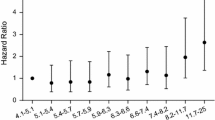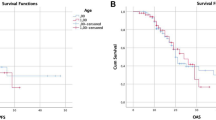Abstract
Background and Purpose
To evaluate the influence of serum hemoglobin level prior to radiotherapy and other prognostic factors on survival in patients with high-grade gliomas.
Material and Methods
From 2001–2010, we retrospectively evaluated a total of 48 patients with malignant glioma treated with surgery and postoperative radiochemotherapy with temozolomide. A total of 37 of 48 patients received sequential temozolomide. Hemoglobin levels were assayed before radiotherapy in all patients. The Kaplan–Meier method was applied to estimate the overall survival, while the log-rank test was applied to evaluate the differences on survival probability between prognostic subgroups.
Results
Results were assessed in 43 patients. The median overall survival time was 18 months (95% confidence interval: 12–40 months). The 1- and 2-year survival rates were 62.2% and 36.3%, respectively. The prognostic factors analyzed were gender, age, extent of surgery, performance status before and after radiotherapy, sequential chemotherapy, hemoglobin level, and methylation of the O-6-methylguanine-DNA methyltransferase gene (MGMT). In univariate analysis, the variables significantly related to survival were performance status before and after radiotherapy, sequential chemotherapy, and hemoglobin level. The median overall survival in patients with a hemoglobin level ≤ 12 g/dl was 12 months and 23 months in patients with a hemoglobin level > 12 g/dl. The 1- and 2-year survival rates were 46.7% and 20.0%, respectively, for patients with a hemoglobin level ≤ 12 mg/dl and 69.6% and 45.7%, respectively, for patients with a hemoglobin level > 12 g/dl.
Conclusion
Our results confirm the impact of well-known prognostic factors on survival. In this research, it was found that a low hemoglobin level before radiotherapy can adversely influence the prognosis of patients with malignant gliomas.
Zusammenfassung
Hintergrund und Ziel
Den Einfluss des Hämoglobinspiegels vor Beginne der Radiotherapie und anderer Prognosefaktoren auf das Überleben von Patienten mit High-Grade-Gliomen abzuschätzen.
Patienten und Methoden
Von 2001 bis 2010 haben wir 48 Patienten mit bösartigen Gliom retrospektiv beobachtet, die mit Chirurgie und Temozolomid-basierter postoperativer Chemotherapie behandelt wurden. 37 von 48 Patienten bekamen Temozolomid sequentiell. Die Hämoglobinspiegel wurden bei allen Patienten vor der Chemotherapie gemessen (Tabelle 1). Die Kaplan–Meier-Methode wurde angewendet, um die globale Überlebensrate abzuschätzen; der Log-Rank-Test wurde angewendet, um die Unterschiede der Überlebenswahrscheinlichkeit bei unterschiedlichen Prognose-Untergruppen abzuschätzen.
Ergebnisse
Es wurden die Ergebnisse von 43 Patienten ausgewertett. Die durchschnittliche Gesamt-Überlebenszeit betrug 18 Monate (95%CI 12–40 Monate), die 1- und 2-Jahres-Überlebensraten lagen bei 62,2% und 36,3% (Abbildung 1). Die analysierten Prognosefaktoren waren: Geschlecht, Alter, Umfang des chirurgischen Eingriffs, Performancezustand vor und nach der Radiotherapie, sequentielle Radiotherapie, Hämoglobinspiegel und Methylierung des O-6-Methylguanin-DNA-Methyltransferase-Gen (MGMT). Bei univariater Analyse zeigte sich eine signifikante Korrelation des Überleben mit den Variablen Performance, Zustand (vor und nach der Chemotherapie), sequentielle Chemotherapie und Hämoglobin (Tabelle 2, Tabelle 3). Die durchschnittliche Gesamt-Überlebenszeit bei Patienten mit ≤ 12 g/dl Hämoglobin betrug 12 Monate und 23 Monate bei Patienten mit > 12 g/dl Hämoglobin (Abbildung 2). Die 1- und 2-Jahres-Überlebensraten betrugen 46,7% und 20,0% bei Patienten mit ≤ 12 mg/dl und 69,6% und 45,7% bei Patienten mit > 12 g/dl Hämoglobin.
Schlussfolgerung
Unsere Ergebnisse bestätigen den Einfluss bewährter Prognosefaktoren auf die Überlebensraten. Wie unsere Studie ermittelte, kann ein niederer Hämoglobinspiegel vor Beginn der Radiotherapie die Prognose von Patienten mit bösartigen Gliomen negativ beeinflussen.
Similar content being viewed by others
References
Becker A, Sadler P, Lavey RS et al. Severe anemia is associated with poor tumor oxygenation in head and neck squamous cell carcinomas. Int J Radiat Oncol Biol Phys 2000;46:459–466.
Brizel DM, Dodge RK, Clough RW et al. Oxygenation of head and neck cancer: changes during radiotherapy and impact on treatment outcome. Radiother Oncol 1999;53:113–117.
Curran WJ, Scott CB, Horton J et al. Recursive partitioning analysis of prognostic factors in three Radiation Therapy Oncology Group malignant glioma trials J Natl Cancer Inst 1993;85:704–710.
Fabrini MG, Perrone F, De Franco L et al. Perioperative high-dose-rate brachytherapy in the treatment of recurrent malignant gliomas. Strahlenther Onkol 2009;185:524–529.
Fadul C, Wood J, Thaler H et al. Morbidity and mortality of craniotomy for excision of supratentorial gliomas. Neurology 1998;38:1374–1379.
Fazeny-Dorner B, Wenzel C, Veitl M et al. Survival and prognostic factors of patients with unresectable glioblastoma multiforme. Anticancer Drugs 2003;14:305–312.
Gorlia T, van den Bent MJ, Hegi ME et al. Nomograms for predicting survival of patients with newly diagnosed glioblastoma: prognostic factor analysis of EORTC and NCIC trial 26981-22981/CE.3. Lancet Oncol 2008;9:29–38.
Iliadis G, Selviaridis P, Kalogera-Fountzila A et al. The importance of tumor volume in the prognosis of patients with glioblastoma. Comparison of computerized volumetry and geometric models. Strahlenther Onkol 2009;185:743–750.
Jeremic B, Milicic B, Grujicic D et al. Multivariate analysis of clinical prognostic factors in patients with glioblastoma multiforme treated with a combined modality approach. J Cancer Res Clin Oncol 2003;129:477–484.
Kang SG, Kim JH, Nam DH et al. Clinical and radiological prognostic factors of anaplastic oligodendroglioma treated by combined therapy. Neurol Med Chir 2005;45:232–238.
Kleihues P, Burger PC, Aldape KD et al. Glioblastoma. In: Louis D et al (eds) WHO classification of tumours of the central nervous system. Lyon: IARC Press, 2007:72–73.
Knocke TH, Weitmann HD, Feldmann HJ et al. Intratumoral pO2-measurements as predictive assay in the treatment of carcinoma of the uterine cervix. Radiother Oncol 1999;53:99–104.
Lacroix M, Abi-Said D, Fourney DR et al. A multivariate analysis of 416 patients with glioblastoma multiforme: prognosis, extent of resection, and survival. J Neurosurg 2001;95:190–198.
Laws ER, Parney IF, Huang W et al. Survival following surgery and prognostic factors for recently diagnosed malignant glioma: data from the Glioma Outcomes Project. J Neurosurg 2003;99:467–473.
Lee WR, Berkey B, Marcial V et al. Anemia is associated with decreased survival and increased locoregional failure in patients with locally advanced head and neck carcinoma: a secondary analysis of RTOG 85-27. Int J Radiat Oncol Biol Phys 1998;42:1069–1075.
Leitzen C, Schild HH, Bungart B et al. Prognoseeinschätzung durch MRVerlaufskontrollen während der Strahlentherapie bei Glioblastom-Patienten. Strahlenther Onkol 2010;186:681–686.
Li SW, Qiu XG, Chen BS et al. Prognostic factors influencing clinical outcomes of glioblastoma multiforme. Chin Med J 2009;122:1245–1249.
Logsdon MD, Eifel PJ. FIGO IIIB squamous cell carcinoma of the cervix: an analysis of prognostic factors emphasizing the balance between external beam and intracavitary radiation therapy. Int J Radiat Oncol Biol Phys 1999;43:763–775.
Lutterbach J, Sauerbrei W, Guttemberger R. Multivariate analysis of prognostic factors in patients with glioblastoma. Strahlenther Onkol 2003;179:8–15.
Lutterbach J, Weigel P, Guttenberger R et al. Accelerated hyperfractionated radiotherapy in 149 patients with glioblastoma multiforme. Radiother Oncol 1999;53:49–52.
Maftei CA, Bayer C, Shi K et al. Quantitative assessment of hypoxia subtypes in microcirculatory supply units of malignant tumors using (immuno-)fluorescence techniques. Strahlenther Onkol 2011;187:260–266.
Mineo JF, Bordron A, Baroncini et al. Prognosis factors of survival time in patients with glioblastoma multiforme: a multivariate analysis of 340 patients. Acta Neurochir 2007;149:245–252.
Odrazka K, Petera J, Kohlova T et al. Prognostic impact of hemoglobin level prior to radiotherapy on survival in patients with glioblastoma. Strahlenther Onkol 2003;179:615–619
Ohgaki H, Kleihues P. Epidemiology and etiology of gliomas. Acta Neuropathol 2005;109:93–108.
Pedersen D, Sogaard H, Overgaard J at al. Prognostic value of pretreament factors in patients with locally advanced carcinoma of uterine cervix treated by radiptherapy alone. Acta Oncol 1995;34:787–795.
Piroth MD, Gagel B, Pinkawa M et al. Postoperative radiotherapy of glioblastoma multiforme: analysis and critical assessment of different treatment strategies and predictive factors. Strahlenther Onkol 2007;183:695–702.
Quilty PM, Duncun W. The influence of hemoglobin level on the regression and long term control of transitional cell carcinoma of the bladder following photon irradiation. Int J Radiat Oncol Biol Phys 1986;12:1735–1742.
Rosenthal MA, Drummond KJ, Dally M et al. Management of glioma in Victoria (1998–2000): retrospective cohort study. Med J Aust 2006;184:270–273.
Rohrer Bley C, Laluhova D, Roos M, et al. Correlation of pretreatment polarographically measured oxygen pressures with quantified contrast-enhanced power Doppler ultrasonography in spontaneous canine tumors and their impact on outcome after radiation therapy. Strahlenther Onkol 2009;185:756–762.
Rudat V, Stadler P, Becker A et al. Predictive value of the tumor oxygenation by means of pO2 histography in patients with advanced head and neck cancer. Strahlenther Onkol 2001;177:462–468.
Shah N, Lin B, Sibenaller Z et al Comprehensive analysis of MGMT promoter methylation: correlation with MGMT expression and clinical response in GBM. PLoS One. 2011;6:e16146.
Stupp R, Hegi ME, Mason WP et al. Effects of radiotherapy with concomitant and adjuvant temozolomide versus radiotherapy alone on survival in glioblastoma in a randomised phase III study: 5-year analysis of the EORTC-NCIC trial. Lancet Oncol 2009;10:459–466.
Stupp R, Mason WP, Van Den Bent MJ et al. Radiotherapy plus concomitant and adjuvant temozolomide for glioblastoma. N Engl J Med 2005;352:987–996.
Tramacere F, Gianicolo E, Serinelli M et al. Multivariate analysis of prognostic factors and survival in patients with “glioblastoma multiforme”. Clin Ter 2008;159:233–238.
Weller M. Novel diagnostic and therapeutic approaches to malignant glioma. Swiss Med Wkly. 2011;141:w13210.
Weller M, Stupp R, Reifenberger G, Brandes AA, van den Bent MJ, Wick W, Hegi ME. MGMT promoter methylation in malignant gliomas: ready for personalized medicine? Nat Rev Neurol. 2010;6:39–51.
Wilhelm R, Kovacs G, Heinrichsohn D et al. Survival of exclusively irradiated patients with NSCLC. Significance of pretherapeutic hemoglobin level. Strahlenther Onkol 1998;174:128–132.
Zips D, Böke S, Kroeber T et al. Prognostic value of radiobiological hypoxia during fractionated irradiation for local tumor control. Strahlenther Onkol 2011;187:306–310.
Author information
Authors and Affiliations
Corresponding author
Rights and permissions
About this article
Cite this article
Ausili Céfaro, G., Genovesi, D., Vinciguerra, A. et al. Prognostic impact of hemoglobin level and other factors in patients with high-grade gliomas treated with postoperative radiochemotherapy and sequential chemotherapy based on temozolomide. Strahlenther Onkol 187, 778–783 (2011). https://doi.org/10.1007/s00066-011-1129-x
Received:
Accepted:
Published:
Issue Date:
DOI: https://doi.org/10.1007/s00066-011-1129-x




